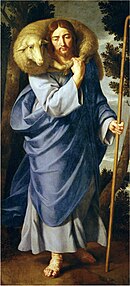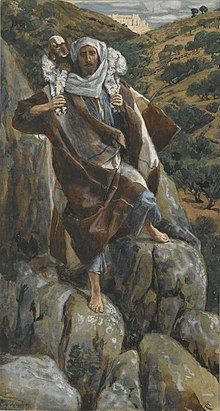Parable of the Lost Sheep: Difference between revisions
m Reverted edits by 50.58.25.126 (talk) (HG 3) |
|||
| Line 20: | Line 20: | ||
[[File:Brooklyn Museum - The Good Shepherd (Le bon pasteur) - James Tissot - overall.jpg|thumb|right|[[James Tissot]] - ''The Good Shepherd'' (Le bon pasteur) - [[Brooklyn Museum]]]] |
[[File:Brooklyn Museum - The Good Shepherd (Le bon pasteur) - James Tissot - overall.jpg|thumb|right|[[James Tissot]] - ''The Good Shepherd'' (Le bon pasteur) - [[Brooklyn Museum]]]] |
||
The image from this parable of the shepherd placing the lost sheep on his shoulders (Luke {{niv|Luke|15:5|15:5}}) has been widely incorporated into depictions of the [[Good Shepherd]].<ref>Walter Lowrie, ''[http://books.google.com.au/books?id=0fwCGTzbMQ0C&pg=PA69 Art in the Early Church]'', Pantheon Books, 1947, ISBN 1-4067-5291-6, p. 69.</ref> Consequently this parable appears in art mostly as an influence on depictions of the Good Shepherd rather than as a distinct subject on its own. |
The image from this parable of the shepherd placing the lost sheep on his shoulders (Luke {{niv|Luke|15:5|15:5}}) has been widely incorporated into depictions of the [[Good Shepherd]].<ref>Walter Lowrie, ''[http://books.google.com.au/books?id=0fwCGTzbMQ0C&pg=PA69 Art in the Early Church]'', Pantheon Books, 1947, ISBN 1-4067-5291-6, p. 69.</ref> Consequently this parable appears in art mostly as an influence on depictions of the Good Shepherd rather than as a distinct subject on its own. |
||
Baca baca |
|||
==Hymns== |
==Hymns== |
||
Revision as of 20:38, 9 January 2014

The Parable of the Lost Sheep is one of the parables of Jesus. It appears in two of the Canonical gospels of the New Testament, as well as in the non-canonical Gospel of Thomas.[1]
According to the Gospels of Matthew (Matthew 18:12–14) and Luke (Luke 15:3–7), a shepherd leaves his flock of ninety-nine sheep in order to find the one sheep who is lost. It is the first member of a trilogy about redemption that Jesus tells after the Pharisees and religious leaders accuse him of welcoming and eating with "sinners."[2] The two parables that follow (in Luke's Gospel) are those of the Lost Coin and the Prodigal Son.
Narrative
In the Gospel of Luke, the parable is as follows:
He told them this parable. "Which of you men, if you had one hundred sheep, and lost one of them, wouldn't leave the ninety-nine in the wilderness, and go after the one that was lost, until he found it? When he has found it, he carries it on his shoulders, rejoicing. When he comes home, he calls together his friends and his neighbors, saying to them, 'Rejoice with me, for I have found my sheep which was lost!' I tell you that even so there will be more joy in heaven over one sinner who repents, than over ninety-nine righteous people who need no repentance."
— Luke 15:3-7, World English Bible
Interpretation

The parable shares themes of loss, searching, and rejoicing with the Parable of the Lost Coin.[2] The lost sheep or coin represents a lost human being.
As in the analogy of the Good Shepherd, Jesus is the shepherd, thus identifying himself with the image of God as a shepherd searching for stray sheep in Ezekiel Ezekiel 34:11–16.[2] Joel B. Green writes that "these parables are fundamentally about God, ... their aim is to lay bare the nature of the divine response to the recovery of the lost."[3]
The rejoicing of the shepherd with his friends represents God rejoicing with the angels. The image of God rejoicing at the recovery of lost sinners contrasts with the criticism of the religious leaders which prompted the parable.[3]
Depiction in art

The image from this parable of the shepherd placing the lost sheep on his shoulders (Luke Luke 15:5) has been widely incorporated into depictions of the Good Shepherd.[4] Consequently this parable appears in art mostly as an influence on depictions of the Good Shepherd rather than as a distinct subject on its own.
Baca baca
Hymns
While there are innumerable references to the Good Shepherd image in Christian hymns, specific references to this parable can be recognised by a mention of the ninety-nine other sheep.
Perhaps the best-known hymn describing this parable is "The Ninety and Nine" by Elizabeth C. Clephane (1868), which begins:
There were ninety and nine that safely lay
In the shelter of the fold.
But one was out on the hills away,
Far off from the gates of gold.
Away on the mountains wild and bare.
Away from the tender Shepherd’s care.
Away from the tender Shepherd’s care.[5]
See also
- Five Discourses of Matthew
- Life of Jesus in the New Testament
- Ministry of Jesus
- Parable of the Good Shepherd
- The Sheep and Goats
References
- ^ Gospel of Thomas: 107 Lamb translation and Patterson/Meyer translation.
- ^ a b c Richard N. Longenecker, The Challenge of Jesus' Parables, Eerdmans, 2000, ISBN 0-8028-4638-6, pp. 201–204.
- ^ a b Joel B. Green, The Gospel of Luke, Eerdmans, 1997, ISBN 0-8028-2315-7, p. 526.
- ^ Walter Lowrie, Art in the Early Church, Pantheon Books, 1947, ISBN 1-4067-5291-6, p. 69.
- ^ The Cyber Hymnal: The Ninety and Nine.
